Corzetti: Edible Art

This is Part 1 of a series
For detailed information and photo essays on how to make corzetti, along with recipes, please delve further into The Corzetti Files:
The Intagliatore of Chiavari, The Corzetti Files – Part 2
Corzetti agli Spinaci con Gorgonzola, The Corzetti Files – Part 3
Where to Buy Corzetti Stamps, The Corzetti Files – Part 4
Corzetti Stampati – and a Giveaway! The Corzetti Files – Part 5
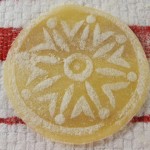 When I first saw one I knew I had to have one. To those of you who know me – no laughing, no eye rolling, please. This time it was for real. And to those of you who do not know me, my friends are laughing because when ever I see any new kitchen item I say I have to have it. But corzetti stamps and the pasta made with them are in a class by themselves.
When I first saw one I knew I had to have one. To those of you who know me – no laughing, no eye rolling, please. This time it was for real. And to those of you who do not know me, my friends are laughing because when ever I see any new kitchen item I say I have to have it. But corzetti stamps and the pasta made with them are in a class by themselves.
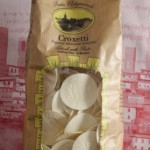 I first came across this unique pasta on the shelf at Williams-Sonoma; I saw the circular embossed corzetti, and I had to know more. Both the stamps and the pasta made with them hail from the area around Genoa, now the capital of Liguria.
I first came across this unique pasta on the shelf at Williams-Sonoma; I saw the circular embossed corzetti, and I had to know more. Both the stamps and the pasta made with them hail from the area around Genoa, now the capital of Liguria.
 The stamps used to make this traditional pasta are charmingly beautiful and ingenious examples of the art of the intagliatore, the wood carver. They are two piece wooden tools that cut and imprint coin shaped pasta and are collectors items in their own right. The stamps and the pasta made from them have had a place in the history of the region for hundreds of years. The presence of these stamps is well documented in the Rinascimento courts of Genoa, and corzetti were so much a part of everyday life for the cinquecento Genoese that they had a second name for their scudi (coins) – they called them croset. That name has come down to us as a delightful pasta called corzetti (in dialect curzetti or croxetti.)
The stamps used to make this traditional pasta are charmingly beautiful and ingenious examples of the art of the intagliatore, the wood carver. They are two piece wooden tools that cut and imprint coin shaped pasta and are collectors items in their own right. The stamps and the pasta made from them have had a place in the history of the region for hundreds of years. The presence of these stamps is well documented in the Rinascimento courts of Genoa, and corzetti were so much a part of everyday life for the cinquecento Genoese that they had a second name for their scudi (coins) – they called them croset. That name has come down to us as a delightful pasta called corzetti (in dialect curzetti or croxetti.)

The bottom of one piece of the stamp is used like a cookie cutter to cut a round piece of pasta.
The top of the cutting piece and the bottom of the second piece are artfully carved and are used to imprint the pasta coins. After the initial pasta round is cut, it is pressed firmly between the two carved sides to produce an embossed design – an edible woodcut. The stamps display family insignias, coats of arms, sheaves of wheat, Christian crosses, palm trees and many other designs. This design is functional as well as decorative; the textured finish of the pasta helps hold its accompanying condimento, or sauce. An intricate design will deliver a flavorful mouthful. The pasta itself can be a traditional egg pasta made with 00 flour, but corzetti are also made with semolina, whole wheat or chestnut flours. In parts of Liguria Parmigiano-Reggiano is added to the dough for a bit of texture and taste. And if you wish to use wine in your dough, the people of Liguria certainly do – make it a Vermentino.

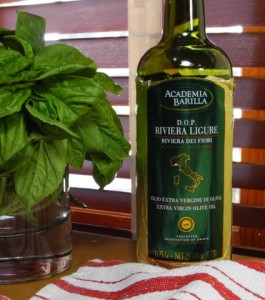 Over the years I have grown to prefer milder olive oils. If you are like me, then Ligurian oil is for you. The region produces oils that are sweet and mild with none of the grassy assertiveness and peppery finish of oils from elsewhere in the boot. Use it in the pasta itself or as part of the condimento. The oil will transport you on gentle wings to the strip of heaven that is the birthplace of this most unique pasta. Corzetti are typically dressed with olive oil and the herbs so abundant in Liguria or with various sauces, sometimes of pignoli, walnuts, mushrooms or fish and very often the glory of Liguria, pesto.
Over the years I have grown to prefer milder olive oils. If you are like me, then Ligurian oil is for you. The region produces oils that are sweet and mild with none of the grassy assertiveness and peppery finish of oils from elsewhere in the boot. Use it in the pasta itself or as part of the condimento. The oil will transport you on gentle wings to the strip of heaven that is the birthplace of this most unique pasta. Corzetti are typically dressed with olive oil and the herbs so abundant in Liguria or with various sauces, sometimes of pignoli, walnuts, mushrooms or fish and very often the glory of Liguria, pesto.
You may also come across Corzetti alla Polcevera, a pasta native to the principal valley of the province of Genoa. Formed by gently pressing the ends of a small piece of dough between the thumb and index fingers of each hand to make a figure eight, it is an altogether different dish from corzetti stampati, and the subject of a post yet to come.
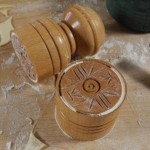 Although one can purchase factory made corzetti stamps at Italian gourmet stores and online, made to order stamps have so much more character. There are very few artisans still doing this work, and most of them are in Italy. In Liguria, to be specific. But lucky for us Americans, and extra lucky for us Californians, Terry Mirri of Artisanal Pasta Tools in Sonoma, California will make a stamp for you. He uses beech, walnut and many fruit woods, and his stamps are works of art. Visit his site, and look at the beautiful woods he uses and the various styles and imprints he offers. You will be as enthusiastic as I. And the news just keeps getting better – he also offers tools one rarely sees – garganelli combs made in the traditional fashion – not the wooden ones so often seen these days. And cavarola boards! Wow, was all I could say. I am happy to see a craftsman working in America making tools that will enable us to keep the culinary traditions of Italy alive for generations to come. Bravo, Terry!
Although one can purchase factory made corzetti stamps at Italian gourmet stores and online, made to order stamps have so much more character. There are very few artisans still doing this work, and most of them are in Italy. In Liguria, to be specific. But lucky for us Americans, and extra lucky for us Californians, Terry Mirri of Artisanal Pasta Tools in Sonoma, California will make a stamp for you. He uses beech, walnut and many fruit woods, and his stamps are works of art. Visit his site, and look at the beautiful woods he uses and the various styles and imprints he offers. You will be as enthusiastic as I. And the news just keeps getting better – he also offers tools one rarely sees – garganelli combs made in the traditional fashion – not the wooden ones so often seen these days. And cavarola boards! Wow, was all I could say. I am happy to see a craftsman working in America making tools that will enable us to keep the culinary traditions of Italy alive for generations to come. Bravo, Terry!
Corzetti Stampati with Pesto
Pesto
This is the quintessential Ligurian sauce, and it is all about harmony. No one component should fight to be heard. Yes, the predominant flavor is basil, but it is basil softened and supported by a well matched chorus of garlic, cheeses and nuts bound together by olive oil. Select an olive oil from Liguria. The region’s oils marry beautifully with basil and offer fulsome support for the other flavors. While many recipes call for pine nuts, I prefer walnuts. In recent years some imported pine nuts have displayed very unpleasant notes, ranging from bitter to metallic. To avoid this I switched to walnuts, and I have come to prefer walnuts over even the finest of pine nuts. And for the cheeses – use only authentic Parmigiano-Reggiano and first rate Pecorino Romano. To finish the pesto I add a tablespoon of very soft unsalted butter. The butter brings all the flavor components together, softening any remaining sharp notes. Traditionally pesto is made by crushing the basil, garlic and nuts in a mortar and pestle. Nowadays most cooks use food processors or blenders. The two methods are not the same; the former crushes the ingredients while the latter cuts them. Purists argue that a mortar and pestle yield superior results. Read on to see which method I use.
2 cups basil, rinsed and dry
1-2 garlic cloves
2 tablespoons walnuts
pinch of sea salt
1/2 cup grated Parmigiano-Reggiano Cheese
2 tablespoons grated Pecorino Romano cheese
1/2 cup – 1 cup extra-virgin olive oil, preferably from Liguria
1 tablespoon unsalted butter, very soft (optional)
Place basil, garlic, walnuts and pinch of salt in the work bowl of a food processor fitted with the steel blade. Pulse several times to roughly chop basil and garlic. With machine running add olive oil until desired consistency is reached. Remove basil mixture from processor, place in bowl and stir in the cheeses and butter.
Corzetti Dough
2 cups 00 or all-purpose flour
2 large eggs plus one large egg yolk
2 tablespoons olive oil
extra flour for the board and towels
Method 1:
Place flour on work surface. Make a fontana (well) in the center by hollowing out a spot about the size of an orange. Place eggs and olive oil in the fontana, and using a fork, agitate to mix. With each stroke of the fork, bring a bit of flour into the mix, being careful to main the integrity of the fontana by moving your free hand around the outside of it and shoring up the sides until all the flour is mixed with the eggs and olive oil. You may have to add more flour if the dough is too wet or a bit of water if it is too dry. Once all the flour is incorporated and dough has come together in a large mass, set it aside, and using a bench scraper, clean work surface. Scatter just a bit of flour over the work surface and knead dough for about 5 minutes, until it is smooth, elastic and just barely sticky. Wrap dough in plastic and allow it to rest 30 minutes.
Method 2:
Place flour in workbowl of food processor fitted with steel blade. Place eggs, egg yolk and oil in a measuring cup and use a fork to lightly mix. With processor running, add egg mixture in a steady stream until dough comes together, about 30 seconds. Check to see if dough is too wet or too dry, adding flour or water if needed. Remove dough from processor and knead about 1 minute. Wrap in plastic and allow it to rest thirty minutes.
Stamping Corzetti
Cut dough into 4 pieces. Keep the pieces you are not working with wrapped in plastic. Working with one piece at a time roll dough by hand to about 1/16 of an inch or to the next to the last setting on a pasta machine. Using a corzetti stamp cut and imprint pasta coins. Place the coins on towel lined trays sprinkled with flour. Cover the coins with a clean dry towel as you work.
Drop coins in abundantly salted water to cook. Please note that there is no salt in this dough, so you must liberally salt the water – a handful of coarse sea salt will do. Cook fresh corzetti about 3 to 4 minutes, less than you cook other fresh egg pastas. You want it to retain some if its bite.
Allow corzetti to cool briefly before tossing with pesto; if the pasta is too hot the pesto will darken considerably. Add a few spoons of pasta water to loosen the pesto just a bit. Divide among plates. Top with grated parmigiano.
Corzetti Stampati
with Brown Butter, Toasted Hazelnuts and Parmigiano
1/4 pound corzetti
1/4 pound unsalted butter*
1/4 cup hazelnuts
grated Parmigiano-Reggiano
Note – these amounts are approximate for a first course for 2 people. Make this recipe your own – q.b., quanto basta – however much pleases you. Preheat oven to 325 degrees. Place hazelnuts on rimmed baking sheet and toast 8 to 10 minutes, until fragrant. Remove from oven. Place hazelnuts in clean kitchen towel and rub together to remove skins. Coarsely chop hazelnuts. Set aside. Make corzetti as above. Brown the butter. For instruction on how to make brown butter, see my post on Ferratelle and my video on browning butter. Drain corzetti well and while hot, toss with a few tablespoons of brown butter. Divide between plates. Top with grated parmigiano and chopped toasted hazelnuts.
* You will use just a few tablespoons of this butter. Store the remainder in your freezer or refrigerator.
One more thing – with a last name like Crocetti, how could I ever resist this pasta?
For detailed information and photo essays on how to make corzetti, along with recipes, please delve further into The Corzetti Files:
Edible Art, The Corzetti Files – Part 1
The Intagliatore of Chiavari, The Corzetti Files – Part 2
Corzetti agli Spinaci con Gorgonzola, The Corzetti Files – Part 3
Where to Buy Corzetti Stamps, The Corzetti Files – Part 4
Corzetti Stampati – and a Giveaway! The Corzetti Files – Part 5
This is Part 1 of The Corzetti Files
Note: You can click on any picture to see a slide show with even more pictures!
I have no affiliation with any product, manufacturer, or site mentioned in this article.
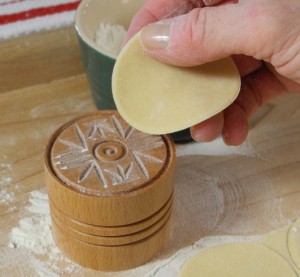
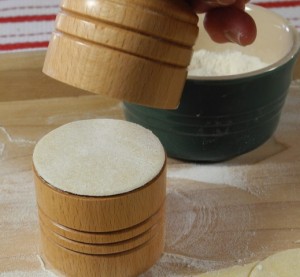

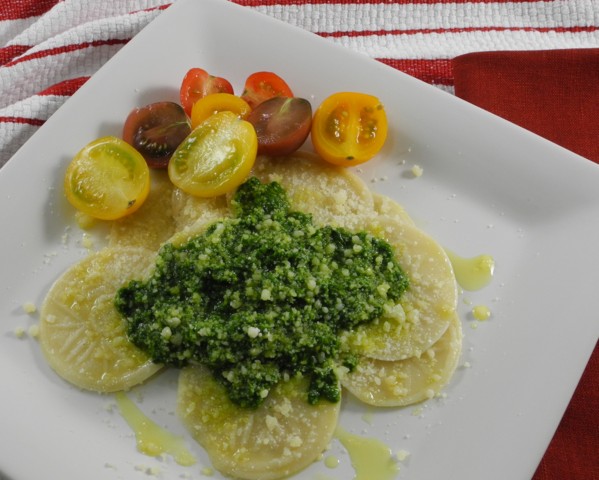




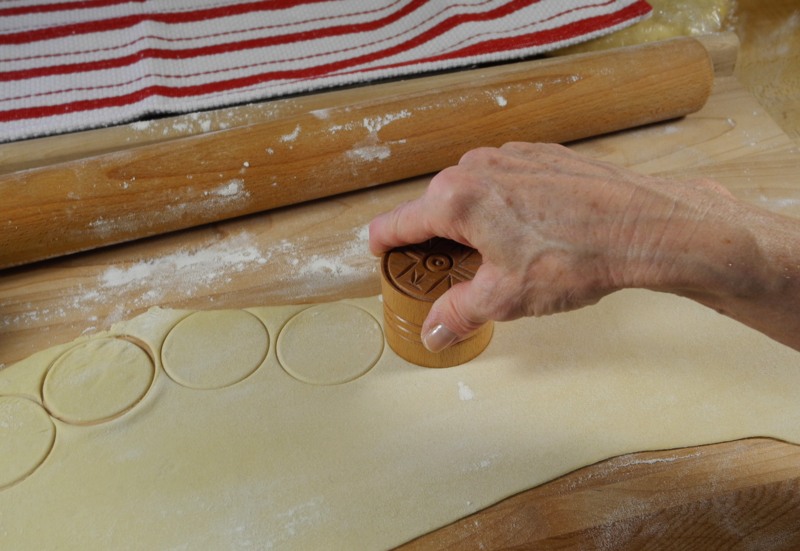
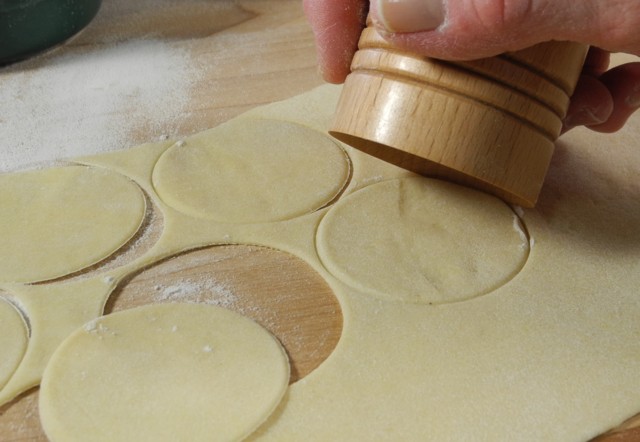




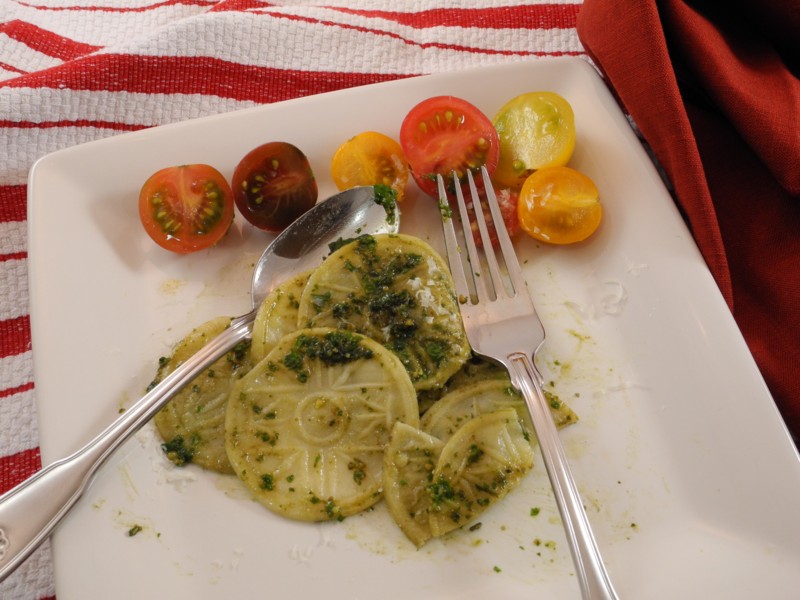

Sunday, August 25th 2013 at 7:12 pm |
What an art! I would so love to find these pasta stamps somewhere! Thank you for educating me! I always enjoy learning more about Bella Cucina Italiana! Baci, Roz
Sunday, August 25th 2013 at 7:54 pm |
Ciao Roz,
Yes, art indeed! Terry’s stamps are glorious, and can be ordered online. I hope you get one. You may see stamps in some Italian cooking supply shops. However, those stamps are typically mass produced and lacking in fine detail work and finish. I’ll be writing about corzetti again soon, and you will see more of the stamps. I hope you begin to make these traditional pasta shapes, joining many of us in keeping these traditions alive in the United States.
Friday, January 10th 2014 at 9:18 am |
I felt like I was reading my own biography! I love buying new kitchen tools and when I read about the Corzetti stamps. I immediately ordered one from Terri. I cannot wait to start making these. The history of these stamps is fascinating. I only wish my mom were alive so I could ask her about this pasta. Her family was not from Genoa but Calabria. She and my dad loved the fact that I wanted to carry on the tradition of making homemade pasta and bread. Now, my 19 yr old grandson has picked up the desire. When he was home for Christmas, we made homemade ravioli and invited the family to be our tasters. They were a hit and now we are spoiled and want only homemade. Thanks for this website. I love reading all the info you offer on all things Italian. Carol
Friday, January 10th 2014 at 10:28 am |
Benvenuta Carol!
Thank you for stopping by. I’m so glad you have discovered my site and corzetti. What a unique pasta! Italian cuisine has endless wonders to offer. Alla prossima!